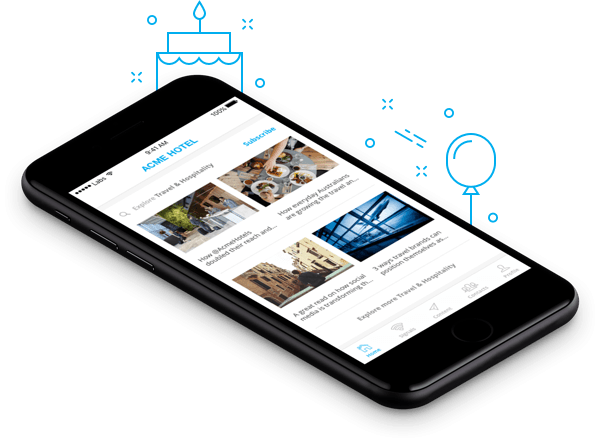
Build Better Employee Engagement through Social Media
Are you having meaningful conversations with your employees?
As trite and overused as the term may sound, it’s relevant – more now than ever. The world is changing under the powerful influence of social media, and that change includes business. The days of ivory towers and Mahogany Row are seriously numbered.
If your only interaction with your employees is through company announcements via email, broadcasts through the intranet or scheduled meetings, or, worst of all, a laser-printed poster pinned to a staffroom noticeboard, there is probably a gap in your internal communications strategy. While these methods are okay – to different degrees – for updates and information, they fall far short of the mark if true team engagement and improved company performance are your goals.
Sure, it’s important to keep your employees updated about company policies, events, and news. It’s also important to keep them updated about what’s really going on.
Your Employees Want To Know
Stating your company’s vision, mission and goals and setting KPIs isn’t enough – not if you, as most highly successful business leaders do, understand the value of getting the team genuinely behind you.
A 2016 study revealed that 50% of employees felt their company’s lack of transparency was what kept the organisation from achieving its greatest success. From the employer’s point of view, that attitude may reveal a lack of faith or trust in the leadership; but from the employee’s perspective, the view is more likely to be a consequence of uncertainty, insecurity, even rumours from outside sources.
And these are the people responsible for keeping your business going, for implementing your processes and strategies. While it’s important for each to know her job, it’s vital too for her to understand how her role is impacting the business as a whole, and what difference it is making.
Naturally, in any competitive business environment, or one in which information can impact your customers or shareholders, not everything should be shared with your employees. But a little trust goes a long way, and keeping your team better informed through can be a powerful internal strategy.
And it doesn’t end there.
Engaged employees have a lot to say. They have ideas, opinions, concerns, and suggestions, and of course, insights. Their input can make a valuable contribution to your business’ success – and the more you listen, the more invested they will be in that success.
“My Door Is Always Open”

Unfortunately, however sincerely it is said, the above line is one of the great lies of our generation (just behind ‘I have read and accepted the terms of use.’) Venturing into the boss’ office can be daunting. Not just the physical barrier of entering a doorway – even open – or approaching a desk. Nor merely the confidence needed to interrupt someone who may be clearly busy: is this important enough to interrupt her? It can also be the fear that an idea may be rejected, feedback not appreciated, a problem curtly dismissed.
Bring on social media – where everybody is equal in profile pic dimensions, where the physical barriers of office walls and desks are gone, where everyone can respond in their own time. Within a closed group, or channel such as Workplace, your team can post their achievements – a simple ‘like’ from their manager can be enough to put a swing in their step. Ideas can be put forward and discussed, refined; feedback can be given.
Your employees know your company inside and out. They know the good and the bad. This puts them in the best position to help achieve your objectives, supporting and improving your brand.
More than that, personally invested in the company, your team can also become your endorsers. Their good experience within the company’s social channels can translate into enthusiasm and advocacy in their own social media circles. The championing of your brand from a supportive employee can easily have the leverage of any paid social influencer – in fact, more so, as the market looks towards personal networks for brand recommendations and information, and as business organic reach declines.
From The Head, To The Heart
Whether inward- or outward-facing, social media for your employees makes good business sense. It gets them engaged, it gets them invested, it gets them advocating.
So how to get started?
As with any social media strategy, knowing your audience is the first step. In this case, finding out which channels your employees are most likely to use. A private page on Facebook, LinkedIn, Instagram; alternatively one of the many business-specific social channels available.
It does pay to have the pages administrated and community-managed by a trusted member of the team, but not with a heavy hand or fanatical loyalty – it’s important to allow robust discussion and criticism, as part of transparency. Influencers within the group can also be encouraged to create and share content regularly in order to keep the channel active and relevant.
Expect some hesitance to use it, at first; but with time, and the right encouragement, it can become part of their work routine.
At a most basic level, the channel can facilitate sharing company news and announcements, discussing issues and policies, gathering feedback, announcing social activities, and offering up opportunities to become involved in projects and brainstorms.

At a more rewarding level, your social media becomes a forum for shout-outs and recognition of peers, a place for you and other managers to celebrate the innovations and hard work of employees, and a place for the business as a whole to enjoy the wins together.
At its best, your internal social media is a source of pride for your team, providing content they will be happy to share with the outside world as truly engaged employees. To this end, a brand advocacy app like Hootsuite Amplify, which even integrates with Facebook’s Workplace, can make it easy for your marketing team to deliver content that your employee network can share, easily and instantly.


